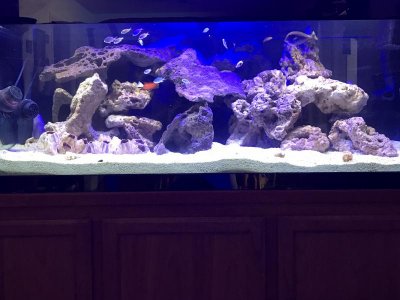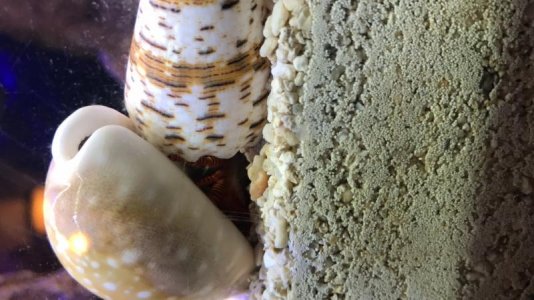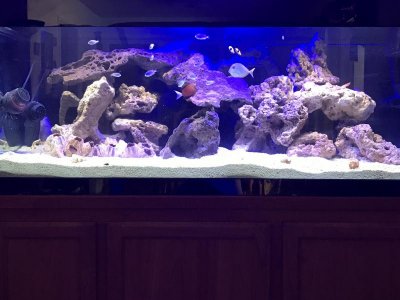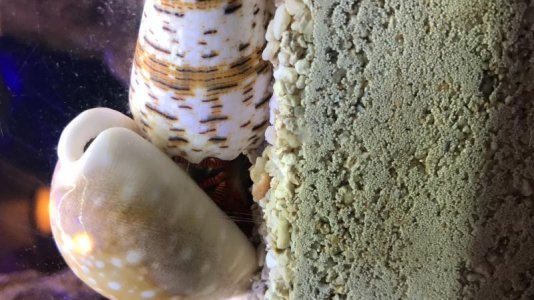I have had 150 setup with FOWLR since 2010. Tank was doing real good until I moved back in March of 2016. When moving I stressed out my fish bad and my sohal broke out in ick. I used cupramine to kill the ick but lost a lot of fish in the process. I was down to a few fish and they were my biggest most aggressive that survived. I couldnt add anymore fish to my tank because whatever I added would get killed by the aggressive tank mates. I also around this time switched careers and neglected my tank. I didn't do a water change for almost 8 months and sold some fish and lost a couple more before just having my blue face as my last inhabitant. I had a power outrage that was out for 2 days and PG&E reimbursed me for my blue face as he died. That's was back in February and my tank sat another month before I decided I wanted to start back up but this time do a reef. I pulled my rock out and did a thorough 75% water change and reaquascaped and added a bottle of bacteria.
My tank is a 150 Euro Braced and after running a month I checked my PH, Ammonia Nitrite and Nitrate levels. All levels were good (Prior to water change I had Small levels of Ammonia and Nitrite). I added my old LED lights that I made years ago (just white and blue leds) and they still worked. Running with a Curent 48" Marine LED as well. I ordered a Maxspect R420R 320Watt 15k that should be here Monday according to tracking. I currently have a Fluval FX5 running ceramics and a 20 gallon sump running an in sump Reef Octopus NW-110 with external pump. My water drains into a filter sock. I picked up a 40 gallon breeder tank and am currently building a better sump which will still have all of the above but also a 16" by 16" refugium (I will also stop using the FX5 when the 40 gallon sump goes in). I have also ordered a Maxspect Gyre XF250 which should be here Friday to replace my 3 Khoralia powerheads. I also plan to line the bottom of my new sump with miracle mud (which if anyone can advise on how deep of a mud bed that would be great as well). I have about 150lb of rock which probably isn't alive anymore since coppering a year ago. I also have a about 4-5" sandbed of a mixture of medium grain Aragonite and fine live sand which also probably isn't alive anymore due to coppering a year ago. I will also be purchasing a second gyre when I get the funds as well as a reactor for GFO. My tank was sold as a 150 but actual volume is around 135. My outside tank measurements are 57 1/4" Tall by 23 1/4" wide by 24" tall. 1/2" thick glass.
April 20 I added some chromis and a small yellow Candy hogfish. A couple of weeks later I added a 3" Lopezi Tang and 3 1/2" White Tail Tang. Friday 5/12/17, I checked my levels again as well as Magnessium, Phosphates, Calcium and Alkalinity. I had a really high Phosphate and a really high Nitrate. A reefer friend told me that my sandbed was most likely causing the phosphate and nitrate spike and that if I wanted to keep a deep sand bed I need critters to move it around. So that night I added a bunch of small hermits about 20, 3 banded trochus snails, 1 sifting star, 2 Halloween Hermits, 10 Nasarius Snails and 2 emerald crabs to help move my large sand bed around. I also added these 2 really cool 1 to 1-3/4 inch gold nugget maroon clowns that I couldn't resist getting.
Friday 5/19/17 I checked my Phosphate and Nitrate again and I'd not seen any change. Yesterday I did an 85 gallon water change with salt water I prepared a day prior. I use RPM salt if that matters. I also siphoned the sand bed really hard when I did this water change (which after reading more I probably shouldn't have). I checked levels this morning and my phosphate was less but still high. My nitrates were between 50-100 ppm range. I know I can't do corals yet because the phosphates and nitrate will cause bleaching. I've been reading a lot and there is a ton of conflicting information out there. I have been a long time lurker on this forum and decided to sign up and join the community.
Some suggestions I've come up with and others have suggested...
1- Remove the sand bed down to 1 to 1-1/2" (I really do not want to do this because I love the look of my deep sand bed)
2- add about 50lbs of more live rock to help bring sand and rock back to life to introduce microfauna back into the tank and allow it to reproduce. Also told I should add copepods, isopods and reef bugs. (I'm down for this if it will help)
3- start removing as much of the aragonite and replace with fine live sand (really don't want to do this either as this will get messy and also my new gyre will end up causing a sand storm with fine sand)
4- dosing vinegar and adding nitrogen sponge to my filter sock (don't want to do this because I'm scared of crashing my tank)
If anyone has any other ideas to get me reef ready I would love to hear. My sump/refugium should be ready within the next week to week and a half as I'm making my panels and drain box out of Corian and things take time to dry. When the sump goes in I will also be adding a GFO reactor and will be running High capacity GFO from BRS. I also used a ULR Hannah Instruments test kit to test my phosphate which only goes up to 200ppb so im unsure of how much phosphate I have.
Sorry for the long lost I just wanted to give as much information as possible. If I'm missing anything let me know. Thanks in advance.
My tank is a 150 Euro Braced and after running a month I checked my PH, Ammonia Nitrite and Nitrate levels. All levels were good (Prior to water change I had Small levels of Ammonia and Nitrite). I added my old LED lights that I made years ago (just white and blue leds) and they still worked. Running with a Curent 48" Marine LED as well. I ordered a Maxspect R420R 320Watt 15k that should be here Monday according to tracking. I currently have a Fluval FX5 running ceramics and a 20 gallon sump running an in sump Reef Octopus NW-110 with external pump. My water drains into a filter sock. I picked up a 40 gallon breeder tank and am currently building a better sump which will still have all of the above but also a 16" by 16" refugium (I will also stop using the FX5 when the 40 gallon sump goes in). I have also ordered a Maxspect Gyre XF250 which should be here Friday to replace my 3 Khoralia powerheads. I also plan to line the bottom of my new sump with miracle mud (which if anyone can advise on how deep of a mud bed that would be great as well). I have about 150lb of rock which probably isn't alive anymore since coppering a year ago. I also have a about 4-5" sandbed of a mixture of medium grain Aragonite and fine live sand which also probably isn't alive anymore due to coppering a year ago. I will also be purchasing a second gyre when I get the funds as well as a reactor for GFO. My tank was sold as a 150 but actual volume is around 135. My outside tank measurements are 57 1/4" Tall by 23 1/4" wide by 24" tall. 1/2" thick glass.
April 20 I added some chromis and a small yellow Candy hogfish. A couple of weeks later I added a 3" Lopezi Tang and 3 1/2" White Tail Tang. Friday 5/12/17, I checked my levels again as well as Magnessium, Phosphates, Calcium and Alkalinity. I had a really high Phosphate and a really high Nitrate. A reefer friend told me that my sandbed was most likely causing the phosphate and nitrate spike and that if I wanted to keep a deep sand bed I need critters to move it around. So that night I added a bunch of small hermits about 20, 3 banded trochus snails, 1 sifting star, 2 Halloween Hermits, 10 Nasarius Snails and 2 emerald crabs to help move my large sand bed around. I also added these 2 really cool 1 to 1-3/4 inch gold nugget maroon clowns that I couldn't resist getting.
Friday 5/19/17 I checked my Phosphate and Nitrate again and I'd not seen any change. Yesterday I did an 85 gallon water change with salt water I prepared a day prior. I use RPM salt if that matters. I also siphoned the sand bed really hard when I did this water change (which after reading more I probably shouldn't have). I checked levels this morning and my phosphate was less but still high. My nitrates were between 50-100 ppm range. I know I can't do corals yet because the phosphates and nitrate will cause bleaching. I've been reading a lot and there is a ton of conflicting information out there. I have been a long time lurker on this forum and decided to sign up and join the community.
Some suggestions I've come up with and others have suggested...
1- Remove the sand bed down to 1 to 1-1/2" (I really do not want to do this because I love the look of my deep sand bed)
2- add about 50lbs of more live rock to help bring sand and rock back to life to introduce microfauna back into the tank and allow it to reproduce. Also told I should add copepods, isopods and reef bugs. (I'm down for this if it will help)
3- start removing as much of the aragonite and replace with fine live sand (really don't want to do this either as this will get messy and also my new gyre will end up causing a sand storm with fine sand)
4- dosing vinegar and adding nitrogen sponge to my filter sock (don't want to do this because I'm scared of crashing my tank)
If anyone has any other ideas to get me reef ready I would love to hear. My sump/refugium should be ready within the next week to week and a half as I'm making my panels and drain box out of Corian and things take time to dry. When the sump goes in I will also be adding a GFO reactor and will be running High capacity GFO from BRS. I also used a ULR Hannah Instruments test kit to test my phosphate which only goes up to 200ppb so im unsure of how much phosphate I have.
Sorry for the long lost I just wanted to give as much information as possible. If I'm missing anything let me know. Thanks in advance.




